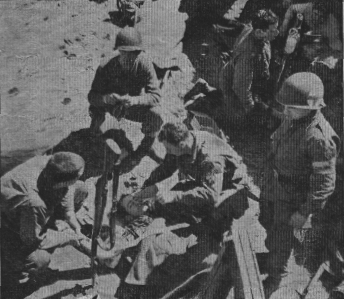Army Wounded Get Chance at Life Thanks to Courage of Medical Aids
In the big field hospital on the way to Metz, ward surgeons crowded around the wounded rifleman just in from a clearing station. Fragments of mortar shell had crushed his throat and cut off his breathing. An emergency tracheotomy (an operation to let in air by an incision in the wind pipe) had saved his life. It was performed in the mud under German fire. The sergeant: Private Duane N. Kinman, a 19 year-old army medical aid from College Place Washington.
A doctor took one look at the neat, professional slit in the man's trachea and nodded: " well, I'll be damned!" Then he asked Kinman how it was done.
Foxhole Surgeon: It happened on November 10, during an attack on the village, Louvigny. Kinman, a former truck driver with two years of high school was bandaging the sergeant's chest wound when he saw the rifleman fall, hands to his throat. The man's face was blue; his breath came in short, harsh gasps. Anyone could see that his wind pipe had been smashed.
Kinman remembered two Camps Barkeley training lectures, more than a year old. Delays in getting air to the man meant death. Crawling through the mortar barrage and machine gun fire, he grabbed the rifleman. Second Lieutenant Edwin M. Eberling of Lincoln, Nebraska held him down. Kinman pulled out and ordinary jack knife. " I don't like to do this, Mac, " he told the rifleman, "but it's the only way you're gonna live. "
Even under the flood lights of modern hospitals with anesthetics, sterilized scalpels, and retractors for holding open the wound, the tracheotomy is a delicate surgical routine. In the mud of battle and the Semi-darkness of a dull November day, it became a race with death.
Carefully, Kinman cut an up-and down slit 1-1/2 inches long in the windpipe below the fracture-a crosswise incision-might have severed the jugular vein. Next he needed a rigid tube to keep the trachea from reclosing. He took the cap of the soldiers fountain pen, punctured the end, and slipped it into the wind pipe. Color trickled back into the rifleman's pallid face; he began to breathe again-through the hole in the top of the pen.
"Now hold the fountain pen in your wind pipe and you'll be okay, Mac," Kinman told him. "You can't breathe through your nose or mouth, but if you keep the wind pipe open with the pen, you can breathe through the cut."
The rifleman held the pen. A few minutes later, he was on his feet. A tank eventually took him to the Battalion aid station. There his injury was described officially as "a perforating wound of the neck with the wound exit over the tracheal area and fracture of the trachea. " But all the doctors had to do was take out the pen in insert a regulation curved metal tracheotomy tube.
Kinman's daring made such a hit with Major Charles D. Bohrer of the fourth Auxiliary surgical group of the thirtieth field hospital that he wrote a letter of accommodation, praising the Aid's "Early and expert performance " of duty under the most perilous conditions. President W. G. Leutner of Western Reserve University offered Kinman a complete post war medical education. " It looks like I've got that the chance I always wanted, Doesn't it? " Said Kinman.
Soldiers without guns: This story, reported last week from Lieutenant General George S. Patton Jr.'s third army front, is only one of many spectacular legends about medical aids - or medical technicians as these enlisted men are officially called-to come in from Europe and the Pacific.
In the last war, the first enlisted man killed belonged to the medical Corps. That corps won more ribbons, crosses, and stars than any other fighting unit on the western front. In this war, medical aids have received just as many decorations and the casualties have run high. No official figures have been released, but that aid man who carries no weapon is just as likely to be hit as the next man.
Although scorned by the troops as
"pill pushers" during training, these aid's take so many risks in
the field but even the most callous soldier gives them credit.
Their are accounts of aidmen going to help the wounded when no one
else on the battlefield is moving.
There are now 559,327 medical technicians in the United States and abroad. They have been trained briefly at Camp Grant, Ill. and Camp Berkeley, Tex. in jobs that range from keeping hospital records to embalming and helping an autopsy. They go through first aid drills under battle conditions; they learn to carry litters over fences, rocks, and walls and down cliffs. The also learn field sanitation, ward nursing, and how to help in pharmacy departments and chemistry laboratories. But the main job is on the battlefield-crawling to a stricken man.